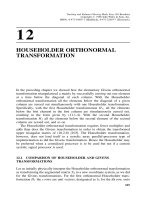Adoption Made Easy doc
Bạn đang xem bản rút gọn của tài liệu. Xem và tải ngay bản đầy đủ của tài liệu tại đây (1.59 MB, 75 trang )
Adoption Made Easy
© Wings Of Success
Page 1 of 1
Adoption Made Easy
© Wings Of Success
Page 2 of 2
DISCLAIMER AND TERMS OF USE AGREEMENT:
(Please Read This Before Using This Report)
This information in this course is for educational and informational purposes only. The content is not presented by a
professional, and therefore the information in this course should not be considered a substitute for professional
advice. Always seek the advice of someone qualified in this field for any questions you may have.
The author and publisher of this course and the accompanying materials have used their best efforts in preparing this
course. The author and publisher make no representation or warranties with respect to the accuracy, applicability,
fitness, or completeness of the contents of this course. The information contained in this course is strictly for
educational purposes. Therefore, if you wish to apply ideas contained in this course, you are taking full responsibility
for your actions.
The author and publisher disclaim any warranties (express or implied), merchantability, or fitness for any particular
purpose. The author and publisher shall in no event be held liable to any party for any direct, indirect, punitive,
special, incidental or other consequential damages arising directly or indirectly from any use of this material, which is
provided “as is”, and without warranties.
As always, the advice of a competent legal, tax, accounting, medical or other professional should be sought. The
author and publisher do not warrant the performance, effectiveness or applicability of any sites listed or linked to in
this course.
All links are for information purposes only and are not warranted for content, accuracy or any other implied or explicit
purpose.
This report is © Copyrighted by Wings Of Success. No part of this may be copied, or changed in any format,
or used in any way other than what is outlined within this course under any circumstances. Violators would
be prosecuted severely.
Click Here To Visit Our Website
Adoption Made Easy
© Wings Of Success
Page 3 of 3
Adoption Made Easy
© Wings Of Success
Page 4 of 4
Adoption Made Easy
© Wings Of Success
Page 5 of 5
Adoption Made Easy
© Wings Of Success
Page 6 of 6
Adoption Made Easy
© Wings Of Success
Page 7 of 7
Contents
All About Adoptions 8
Why You Should Choose Adoption 10
Adoption Statistics – Some Telling Facts About The Process Of Adoption 12
Adoption Dos & Don’ts 14
Children Awaiting Adoption 16
Steps to Put Your Child Up for Adoption 18
Adoption Resources 20
Adoption Photo Listing 22
Adoption Records - Why Are They So Important? 24
How To Prepare For The Home Study As Part Of The Adoption Process 26
Adoption Lawyers 28
Adoption Agencies 30
Choosing the Right Adoption Agency and What to Expect 32
Four Places to Help You Find the Right Adoption Agency 34
Where To Find Financial Help When Adopting A Child 36
First-time Adoption 38
Meeting Your Adoptive Child 40
Preparing The Home For An Adoptive Child – 5 Steps 42
Types of Domestic Adoption 44
The Differences Between Open and Closed Adoptions 46
Deciding Between Open and Closed Adoptions 48
Adopting Your Stepchild 50
Adopting Siblings 52
Adopting A Special Needs Child 54
Transracial Adoption 56
Adoption from Same Sex Couples 58
Public Adoption 60
International Adoption 62
The Pros and Cons of International Adoption 64
Canadians Adopting From The US 66
Russian Adoption 68
Vietnamese Adoptions 70
Adopting from China 72
Adoption Made Easy
© Wings Of Success
Page 8 of 8
All About Adoptions
Adoption is when the birth parents of a child sever all legal ties to their child, and the parental
rights are legally given over to the new adoptive family, who are strangers.
Apart from adopting a child from your own country, intercountry adoption is also available as
there are also many children from international countries who need a family.
In the UK and the USA, children are usually given up for adoption because they have been
mistreated; other reasons are due to teenage pregnancy, or because the birth parents are no
longer able to look after the child, or they have given up the child because it isn't the right sex, it
has some form of disability, or because they simply don't want a child.
There are many different reasons for wanting to adopt - if couples are unable to conceive, if they
want to help others by adopting, and now there are same-sex couples who prefer to adopt.
The adoption process varies from one country to another. The ethics for eligibility can differ in
each country which can include the age limit, the requirements for same-sex adoption couples,
and whether a single person is able to adopt.
Placing a child into care and up for adoption is free in the United States. Adopting fees for the
parents vary in different countries, and even in some, to charge an adoption fee would be illegal.
In the United States, for adoptions you are given a $10,000 tax credit.
The new parents face many concerns in adoption. The child's family history and their family
medical history may be unknown, or kept secret until the child starts to ask questions about
where they come from. This usually happens when a child is old enough to ask the right
questions, or when they feel the need to 'find themselves'. There are always misconceptions
about children who have been fostered and this is usually fuelled by the media. Some children
are thought of as not being able to develop properly or will become problem, but that is not
always the case, as children can fare well when given a new, loving home and go on to lead
successful lives. However, many children lose out and some reach the eighteen when they are
too old to be adopted and are legally adults. They fall out of the system.
Adoption Made Easy
© Wings Of Success
Page 9 of 9
Not everyone chooses to understand or support adoption, although Americans are experienced
in it. The history of adoption can be traced as far back as the 18th Century B.C. During Ancient
times it was more popular to adopt adults rather than children so that they could carry on the
family heritage or to protect the family's property rights. Men and women single or married had
the right to adopt.
Modern adoption laws are based on the heritage in 18th Century B.C. of the Hammurabi Code.
Adopting adults was the focus in Ancient Times as a means for someone to follow in one's
footsteps; whilst the Middle Ages set some ground rules with their focus on the adoption of
children. Certain laws were placed in order to protect children, so by this time adoptions were
dealt with by the court systems. It was in 1851, in Massachusetts, that the first state adoption
took place. Rev. Charles Loring Brace was the founder of the New York Children's Aid Society
in 1853, which helped orphaned and abandoned children. He wanted to rescue these children
and transport them to good Christian homes. They were placed on Brace's 'Emigration Plan'
onto regular trains called the 'Orphan Trains' for families to view at each station, until they were
taken up by one of many of the wealthy farming families.
Times have changed, although we still want the best for our children, although it is still
sometimes difficult to know what that is. Adoption is one of the best things to have happened
over the centuries, to give children without a home a good chance to find one.
Adoption Made Easy
© Wings Of Success
Page 10 of 10
Why You Should Choose Adoption
All you need to know about adoption; is it the right choice for you and your partner, or your
family if you already have children.
For many people unable to have children of their own, adoption is the only answer to their
prayers. It answers all the hopes and dreams of ever having a child they can call their own.
Many people all over the world are not able to have children due to health reasons or who have
tried I.V.F. (In Vitro Fertilization) treatment and been unsuccessful. Some have tried may
fertility treatments and still been unable to conceive. To experience so much disappointment is
heartbreaking when a couple is desperate for a child. To be told by their doctor, that they will be
unable to have children naturally is enough to shatter anyone's dreams.
If a couple cannot reproduce adoption is their only alternative and not a decision to be taken
lightly. It takes a lot of time, research and discussions with health professionals for a couple to
decide on whether this is the right option for them. For many couples, adoption provides them
with any hope of raising a child they can call their own. Sometimes it is enough to find
happiness in other people's children, related or not. The opportunity of becoming a family is a
privilege and being parents can bring a lot of happiness and joy. Couples usually start by
adopting one child, and then some years later, they may decide to adopt another.
There are other reasons for choosing adoption; some couples can conceive and reproduce, but
opt for the alternative to adopt. Families used to consist of many children, up to five or more
children. These days due to the cost of living and with couples both working, today families
usually consist of one, two or even three children. It is only a few who choose to have larger
families. To be financially secure, having a family and working is usually important. A mother
will usually take maternity leave, then return to work either part-time or full-time, however they
feel as there are also childcare fees to consider. By choosing to adopt, a couple are providing a
home for one of millions of children in care around the world; children who are looking for a
loving home and parents to love them. Luckily, for these children, couples who actively seek to
adopt realize this need and choose this path, rather than reproducing their own. It is truly a
selfless act when a couple decide to adopt and a lot of admiration for deciding to take on a child
that is not genetically their own.
Adoption Made Easy
© Wings Of Success
Page 11 of 11
Families that already have both parents and their own children, also choose to adopt a child.
They are financially well off and wish to provide for another child who is looking for a family.
Parents and their children alike, sometimes have the compassion on seeing those children that
are in need. What better way to provide a home for them where they are truly wanted, helping
someone who is less fortunate. The families are committed to welcoming a child locally,
nationally and sometimes internationally into their loving, stable family environment. Some
parents have children that have grown up, and feel they are not ready to give up being a parent;
they are healthy and young enough to carry on bringing up another young child.
Adoption for anyone is a selfless and wonderful act full of compassion and love. For many
unable to conceive it brings their only hope of ever having children of their own; for others it's a
choice to help someone who is less fortunate and needs their love and support. Adopting a
child, and sharing the love they feel brings happiness and the dreams of a bright future ahead.
Adoption Made Easy
© Wings Of Success
Page 12 of 12
Adoption Statistics – Some Telling Facts About The Process
Of Adoption
To know the bigger picture regarding what the nature and process of adoption is all about;
adoption statistics are more than just numbers for people looking to adopt and those hoping to
study the patterns and history of this vital way to building a family and therefore the nation, in
turn. Many Americans have been touched by this process of adoption and just a decade ago, in
1997, Evan B. Donaldson Adoption Institute conducted a survey to report over 60 per cent of
US families had experienced adoption in some form or the other. In some instances, the
participant was a product of an adoption, in others, one or more family members or a friend had
been adopted or had placed a child for the same process. Thus, we find that this interesting
study reveals a major portion of American families have been affected in some way by adoption.
The other aspect of adoption relates to the female demographics: women who place their
unborn kids up for adoption. This is known as prenatal adoption and usually such women tend
to have an inverse relationship with their socioeconomic status (SES) and academic level;
sometimes, the decision is influenced by that of the birth mother and at others, by those within
her family who are linked to these factors. E.g. a woman with a mother having finished at least a
year college is statistically 3 times more likely to place a child for adoption than one a woman
whose mother did not graduate high school, reveal studies. Research claims that the latter
come families less supportive of giving the child up for adoption which the former are lucky to
have, but females from lower SES and academic backgrounds may equally be decisive about
giving their children for adoption felt one California research.
Some of these adoption statistics and opinions may be somewhat outdated but as with other
issues, the commercials have not been tampered with or changed much, giving us reasonable
information that is accurate and revealing about the estimated cost of adoption: the adoption
agency hired to find a child is the chief cost incurred by prospective parents. Hiring a local
agency for a domestic adoption (public agency) may cost around $2500 or even less than that
to nominal amounts, especially the non-profit ones, whereas if handed over to a private agency,
the cost of adoption can range from $4000 to $30,000 because these are not subsidized by the
state and also offer support services later.
Adoption Made Easy
© Wings Of Success
Page 13 of 13
However, the important thing to remember when discussing adoption statistics is that these
numbers are only a small element of the adoption procedure and to be used merely to gain an
insight into the past of adoptive processes and trends; they are not meant to be yardstick for
future figures - go by insight.
Adoption Made Easy
© Wings Of Success
Page 14 of 14
Adoption Dos & Don’ts
We cover some essential do's and don'ts regarding adoption in this article and we hope these
will help the thousands of couples looking to adopt a child and build a family unit. It is necessary
to comply with these state outlined adoption rules so as to make the adoption process a legal
and successful one, therefore learning about the basics of proper adoption procedures is a big
help for prospective parents and they should educate themselves about these to avoid
disappointments and debacles later.
Some of the adoption rules are very strict and not following them to the 't' may cause the couple
to forfeit their chances at a promising adoption, so prospective parents looking to adopt a child
are advised strongly to learn about the rules and play by them too, in order to obtain lawful and
above-board privilege to adopt from the state concerned.
All details of the adoption process must be outlined before hand and prospective adoptive
parents must make an effort to educate themselves on all aspects of the adoption procedure,
including costs and timeline issues besides the state's adoption regulations and checking for
their own eligibility criterion to ensure all details are in order.
They must also carefully go over the adoption contract to ensure they have not missed out on
any relevant point or slacking in giving correct and updated information as well as submit and
file all necessary documents for speedy processing of the same; if they do not understand some
of the legal aspects or details, it is advisable to contact an adoption lawyer or consult an agency
to clear these doubts instead of overlooking important issues. Being a long-drawn out
procedure, prospective parents must also consider and prepare beforehand their finances for
covering the decision to adopt as it can involve many different types of fees.
Prospective parents should understand the various risk factors associated with adoption and
work to eliminate these! One of the most typical risk factors involved in adoption includes the
birth mother suddenly changing her mind and wanting to raise the child herself; proper
screening of the birth mother can help prospective adoptive parents minimize those candidates
who exhibit a potential risk of indecisiveness and zero in on those that are likely to go through
Adoption Made Easy
© Wings Of Success
Page 15 of 15
with the agreement. This precaution can help reduce disappointment at losing out on a child that
could have been yours.
Besides the above factor, adoptive parents also need to keep their emotions in check and keep
anxiety at bay to avoid making mistakes at crucial points in the adoption procedure as many
nervous parents are prone to doing; unnecessary haste and ill-informed parents going in for
adoptions make for bad decisions that do not bode well for wanting to build a real family.
Understand that adoption process takes time and take this time to read, review and ascertain all
aspects of legal documents to ensure an official adoption as well as a lawful one.
Do not be guided by just about anyone when you are looking to adopt a child: go over the legal,
social, mental and medical aspects besides the cultural ones of the child as well as academic
ones to ensure the right fit for your family environment and your emotional needs; avoid frauds
and touts.
Adoption Made Easy
© Wings Of Success
Page 16 of 16
Children Awaiting Adoption
Most people looking to adopt children always ask questions about what a child is like. This is an
important factor to consider, as any parent who wants to welcome a child, who is not their own,
into their home, needs to know all about a child and all the options available to them. Every
child is different so it is difficult to know what to expect of a child, and also being placed in a
different environment can change a child. By looking at children who have already been
adopted, a general picture can be painted of what to expect.
By adopting children within the U.S. these will generally be infants who are African-American
Hispanic, or of mixed race. Caucasian children are usually dealt with by private Adoption
agencies and not put up for public adoption. There are many people who wish to adopt an
infant from an early age, maybe to simulate the experience of bringing up a child from birth.
There are long waiting lists for people wishing to adopt a baby as it is the most popular choice,
and it is difficult to find a child that young who has been placed for adoption, so it could be some
time before a child becomes available.
The second domestic option is to adopt a child from a foster family and waiting for a permanent
home. Usually these children are older, ranging from grade school age up to adolescence.
Some of these children have special needs - whether it be emotional, mental and or including
physical disabilities. These are often called 'waiting children' and are treated as special cases
which are handled by both public and the private adoption agencies. They have entities called
adoption exchanges so that a suitable match can be found between the child and the parents. If
a child has special needs, adoption subsidies are often available for the parents to help with the
costs of caring for the special needs child.
The third option is to adopt a child internationally. There over fifty foreign countries to choose
from that have children available for adoption. There are many reasons why a child is placed
for adoption, which is usually connected to their race or culture of their parents. An example is
that in South Korea, if a mother is unwed they are looked upon with shame, so the mother
usually puts the child up for adoption. Many of these children can be found in orphanages,
Adoption Made Easy
© Wings Of Success
Page 17 of 17
waiting for someone to come along and adopt them. Adopting a child internationally can be a
long and arduous process, but there are agencies and attorneys set up especially for this.
Each individual has to find the option that is most suitable for them, but no matter: there are
many children out there who available and hoping to be adopted. The children range from
babies to adolescence, and can be found at home or abroad - children who have no families.
For those parents expecting a child, and those wishing to adopt, adoption can be the solution
and should be given careful consideration. More information can be found from sources online -
Adoption.com and Adopting.org. These both provide essential information about adoption for all
parties concerned. Adoptablekids.com has photo listings of many children who are currently
available and waiting to be adopted; this adoption exchange internet service is excellent for
those who like to search and browse and see who is available.
Adoption Made Easy
© Wings Of Success
Page 18 of 18
Steps to Put Your Child Up for Adoption
Considering putting your child up for adoption? For whatever reason, read on so you can
determine the best solution for all!
Some mothers become pregnant unexpectedly, at a time where they are unprepared and feel
unable to cope with a child, and all the responsibilities of being a parent. Issues that a person
may come across include financial worries or lack of funds, emotional problems or physical
disabilities. When faced with pregnancy some people have an abortion; others may not feel that
is right to terminate a pregnancy, and some have left it too late as they did not know they were
pregnant. One option is to put your child up for adoption - this is a good idea if you feel that
you truly cannot care for the child on your own as you don't have enough support. The following
shows the process, step by step, for putting your child up for adoption.
Firstly, you should make an appointment to see your General Practitioner before the birth, and
let them know that you wish to put your child up for adoption. If you feel more comfortable
talking to a stranger rather than your doctor, you can always make arrangement to a
professional at your local health center. They will have all the information necessary about
adoption and put you in touch with the relevant agencies. There are many bogus adoption
agencies claiming to be professional, so it is important to go to your local health services who
have a list of licensed agencies. That way you can feel confident that the adoption agency you
are dealing with are legitimate.
Next, you should get all the information on your medical records if you are going to put your
child up for adoption. If at all possible, the father of the child should be encouraged to get hold
of his medical records too as this is important information. It is important that the medical
records of the child are recorded for future reference. The child's medical records can get lost in
the process of adoption, so it is a good idea to have the parents' medical records. This is very
helpful if a child becomes ill, especially if they need hospital care, to determine what could be
wrong with the child, or if there is anything to look out for in the future. It could prove very
beneficial if you can also obtain the medical records of the child's grandparents.
Adoption Made Easy
© Wings Of Success
Page 19 of 19
Thirdly, now that you have decided to place your child up for adoption, you need to make a
decision on whether to have an open or closed adoption. An open adoption allows the parent
can continue to have interrelations with their child even though they have been adopted, so that
they can keep close ties. Some parents opt for a closed adoption if they want to cease all
contact with their child, in the best interest of the child, so that they consider their adoptive
parents as theirs. It is more common for parents to choose an open adoption so they can
continue to interact with their child and never sever that bond they feel for their child. If this is
what you prefer and it works well for both parents, then an open adoption is the right choice for
you.
Adoption Made Easy
© Wings Of Success
Page 20 of 20
Adoption Resources
For adoption resources to be useful, couples looking to adopt may consult individuals or
agencies that deal with this specialized family building up segment to get more information
about types of adoption, (private, domestic, International, special needs or Open etc) and learn
which one will suit their personal situation best.
Adoption resources help to educate couples interested in adopting a child about the various
kinds of adoption processes, procedures and fees involved, professional expertise available for
making the action an easy one and legal aspects of the decision to adopt. At times, written
matter regarding adoption aspects help prospective parents learn more about the pros and cons
of adopting, what are the mistakes they can make, how to avoid these and ways to avoid
disappointments. It is important to learn about the downside of adoption as well to be aware of
the all-round aspect of a major life-changing decision and thus adoptive parents are advised to
focus on these as much as they are keen to know about the positive side of adopting their
special child.
Prospective parents can further query adoption resources centers with other details that are not
mentioned in the written resources given to them and these can usually be found at social
services or child welfare organizations, state departments' agencies that support domestic
adoption etc. Adoption resources usually contain basics about the nature, scope and regulations
of adoption from the chosen place, besides restrictions on couples regarding the procedure,
eligibility criterion for adoption and facts and figures to guide adoptive parents about the steps
towards legal adoption procedures.
Besides local groups and adoption centers, there are many publications in the market today that
deal with various aspects of adoption and even the Internet is a good adoption resource for
those that cannot contact an agency or state center dealing with adoption. From books on
adoption to associations and groups directly dealing with adoption procedures to helping find
lawyers and professionals for the job, the web is a great place for helping adoptive parents
reach out to appropriate contacts. From facts on International adoption to laws on Inter-state
adoption to statistics about available children across different geographical locations, there is
comprehensive information available on thousands of websites that is sure to benefit
Adoption Made Easy
© Wings Of Success
Page 21 of 21
prospective parents looking to give a child a place in their heart and home. Besides the net,
contacting an adoption agency or a non-profit adoption organization is also a good bet for
prospective adoptive parents if the financial side of the adoption process is not much of a
strain since the charges for searching and matching a child according to individual requirements
can be considerable, especially in the case of International adoptions
Adoption Made Easy
© Wings Of Success
Page 22 of 22
Adoption Photo Listing
Adoption Photo Listing is where an adoption agency, or even Social Services who deal with
adoption, post pictures along with information about children up for adoption on the internet.
This is a popular practice used in most counties and internationally which improves the chances
of a child to find a family. The United States have about 100,000 children in foster care and all
over the world there are many more in there thousands who live in children's homes,
orphanages or in temporary care. All those children who are up for adoption and need a home
are pictured on Adoption Photo Listings. Most children are over seven years old, and the
majority are older than that and come with special needs. These children come with problems -
emotional, mental and some have or include having learning disabilities. There are also
children with physical disabilities. Many sibling groups will wish to be kept together, so it is
better to do your homework and find out more about a child or children before you decide to
adopt.
If you are interested in a child you can then request further information about them. It was in
1994 that Adoption Photo Listing started and since than more than 8,000 children have been
pictured. On the internet, over two million hits a month have been received by the Adoption
Photo list. People who have even the slightest interest in adopting can view the listings, which
has been powerful at attracting people. They can browse and read about these children who
need a loving, stable environment and parents to care for them. Most people have a fair idea of
how many children worldwide who are in need of a home but that is just a number based on
statistics. By reading about a child and having a picture in front of them gives a couple
something they can visualize. They can find about a child's date of birth, their nationality and
background, their likes/dislikes and where they come from.
Adoption Photo Listing benefits a child up for adoption greatly, as it gives them more of a
chance to find parents who can adopt them. Having their picture and information available for
those who want to adopt, allows potential parents to learn about the children. As websites are
usually updated, they can also keep an update on how a child is doing physically and
emotionally and to view more recent pictures as written information with updates is not much to
go on.
Adoption Made Easy
© Wings Of Success
Page 23 of 23
Adoption Photo Listing doesn't just list children available for adoption, it also has pictures of
those prospective parents who wish to adopt. They have all been previously assessed and
screened by Social Services and deemed suitable according to requirements. Some couples or
families are unable to have children through one health problem or another, and so wish to
adopt. The information about them include pictures, whether they are married or not and any
other children they may have, biologically their own or adopted. It also includes their pastimes
and where they live with information about their reasons for wanting to adopt, and the fact that
they would like to be considered.
Adoption Photo Listings have done much to help many children to find new parents to adopt
them and also those seeking to adopt.
Adoption Made Easy
© Wings Of Success
Page 24 of 24
Adoption Records - Why Are They So Important?
While it is true that most of the info collected on a child put up for adoption is documented on
the child's adoption records and these are typical of most states, which means an inclusion of
comprehensive medical and genetic background details besides social, mental health, religious,
ethnic and educational records, some states may require even more in-depth information. This
includes more detailed family history and racial origin details as well as dental history,
vaccination and developmental health records and the mandatory academic progress records.
At times, adoption records may also contain eligibility information or exclusivity outlines that
indicate the states where the child can be adopted with federal adoption support, such as
extended to citizens of the States of Michigan, Missouri, Nevada, Texas, Vermont, Oklahoma
and Rhode Island.
Apart from birth parent's history and background details, a home study also serves the purpose
of enabling the adoption agency or state department with the opportunity to gather info on
medical history, socio-economic background, the family's mental health history, spiritual
inclinations and to what extent the child's parents are educated; all these details help determine
a child's future and are included in the adoptive records. Still other states ask for more detailed
adoptive records that include description of parent's looks, skills, hobbies, career and
medication that the birth mother may have been taking at the time of her pregnancy; other
states exist that provide adoptive parents further identifying info about the birth parents and the
child's background such as name and address (Colorado, New York and American Samoa are
some examples.)
Adoptive records help prospective parents determine what kind of a family background they are
willing to adopt a child from and also where vice versa i.e. help the birth parents and
state/adoption agency ascertain whether the adoptive family's atmosphere and background will
be suitable to the child concerned. Thus, the home study also includes aspects of a couple's life
that may affect the adoption of a child, such as a criminal background, instance of child abuse
or history of the prospective parent's health, emotional maturity and stability of finances besides
the social aspects.
Adoption Made Easy
© Wings Of Success
Page 25 of 25
Among the hardest states to adopt from, Montana is surely the one that tops the list, for they
ask for occupational, drug or alcohol abuse and domestic violence history besides the racial-
ethnic background details of the adoptive parents and some of these categories of information
also need to be filled up by the states of New Mexico, North Carolina, South Dakota, West
Virginia, Arizona, Illinois, Vermont, Puerto Rico, Pennsylvania and the District of Columbia, for
their adoption records.
After the final documentation for the adoption records as required by these demanding states
has been filed properly and is found to be in order, they are duly signed by the judge and
depending on the type of adoption procedure the couple concerned have opted for, these are
sealed and kept confidential or left open to the public. In the case of an adoption record that is
kept confidential, it is kept this way till such time as the adopted child becomes an adult.









